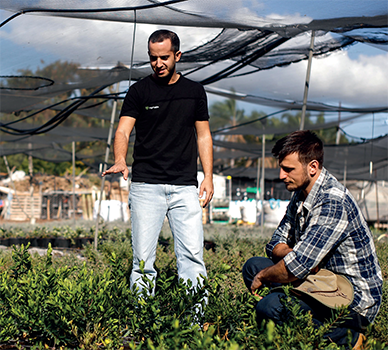Agro-informatics trends transforming the food industry in 2023 By Ron Baruchi
Driving the food industry forward from the ground up, the agricultural industry looks much different today than it did hundreds of years ago. Mechanization changed agriculture’s reliance on human labor and horsepower. The Green Revolution harnessed selective breeding allowing more grain to be produced per acre, helping to feed the growing population and enabling food producers to create new products. Over the past few years, this change has continued, with an increasing focus on sustainability worldwide, as a result of consumer demands and changing production policies. A large part of this is also driven by the agricultural industry, where sustainability improvements are fed throughout the production chain.

In 2023, we’ll see an increasing number of familiar challenges being addressed with new technologies. While mechanical technologies continue their development, it’s the digital technologies we will see driving the most change within agriculture. Below, I’ll dive into four of the largest upcoming agro-informatics trends I see pushing sustainable change in food production in 2023 and beyond.
A focus on increasing production to meet growing global needs
The Food and Agriculture Organization estimates that by 2050, we will need to produce 60 percent more food to feed a world population reaching nearly ten billion. Even if we hit that mark, 300 million people will still be grappling with food scarcity.
Developing countries will play a key role in this global food supply. Today, countries like the Philippines and Colombia are setting records for US exports. In 2023, developing countries will continue to account for most of the growth in US agricultural exports.
As indicated by the US Farm Service Agency, there will be 1.2 million fewer acres dedicated to corn production in the United States. As a result, farmers will need to have significantly higher yields from their land in order to meet the food needs in the face of a growing global population. For the food industry, this represents a significant supply chain risk.
In the past few years, extreme weather events, Covid-19 supply chain disruptions, and worldwide economic concerns have severely impacted food and beverage supply chains. These factors will continue, and more will join, carrying the potential to shift the reality of 2023 from these projected outlooks.
An increased use of AI-based digital tools
As technology adoption grows, the digital age continues to thrive. In farming, adoption has the potential to mitigate the previously mentioned supply chain risks. From measuring soil nutrient levels to monitoring irrigation and using drone imagery to map and estimate disease presence, Artificial Intelligence (AI) will become a constant presence in agriculture, enabling more efficient, predictable food production and higher quality raw ingredients.
Global spending on smart technology and connected systems in the ag space is projected to triple in revenue by 2050. With it, the capabilities of these technologies will grow, in turn enabling food producers to benefit. For food producers who own the farms from which they harvest raw ingredients, investing in such digital tools could be revolutionary.
Closely related, synthetic data is often used to validate AI models. Based on real-world data, and created by a model that uses the parameters of real-world datasets, it can be used to create a digital twin. This synthetic digital twin could be used to more accurately predict and even impact the amount of raw ingredients a food and beverage company will receive, improving planning capabilities. With so much potential, use of this will increase, with Gartner predicting it will outpace real data in AI models by 2030.
A larger use of precision agriculture, primarily to decrease production costs
Precision agriculture harnesses smart, connected technology systems to improve grower outcomes. Growers can save time, money, and resources – all at a premium in today’s world – with tools that support crop monitoring and targeted crop nutrition plans. This makes producing the raw ingredients cheaper, with cost benefits being passed to food producers.
In 2023, using precision AgTech tools for precise fertilizer application will be more important than ever, driven by rising fertilizer costs. Fertilizer costs increased the most of any input in 2022, with projections that this will further increase over the coming year. With no other way to recoup the costs, farmers have been raising the price of their produce, making profit margins smaller for food and beverage companies. The improvement of precision agriculture means farmers input costs will be reduced, creating a positive knock on effect.
 A continued focus on sustainability
A continued focus on sustainability
Sustainability isn’t a new trend or topic in 2023, but it’s a safe bet that companies will double down on their efforts. To do so, they’ll need to quantify their impact on sustainability. To consumers, a highly sustainable product is a great selling point, and food producers can significantly improve their sustainability ‘scores’ by sourcing sustainably grown ingredients.
Along with positively impacting the environment, financial benefits of environmental sustainability also exist. As well as the numerous carbon markets available for US producers, the USDA’s Natural Resources Conservation Service is offering technical assistance and financial support for improving air quality, conserved ground and surface water, soil health, improved or created wildlife habitats, and more, encouraging farmers to grow sustainable ingredients for the food industry.
Staying abreast of all the industry changes can be a challenge. However, with pressures from a changing climate and growing population, adapting is necessary.
Quickly understanding the impact of new technologies or production practices on raw ingredient supply and quality is critical in driving profitable and sustainable change. Reviewing available research can help to predict plant growth and development. In turn, this allows food and beverage companies to predict their supply of raw ingredients, an invaluable foresight for planning. Ultimately, it pays food companies to consider the stage before the factory – the growing of raw ingredients.
For a list of the sources used in this article, please contact the editor.
Ron Baruchi
www.agmatix.com
Ron Baruchi is CEO of Agmatix, an agro informatics company that develops data-driven solutions for ag professionals worldwide. Its cutting-edge technology platform uses agronomy data science and advanced AI technology to convert agronomic data into actionable insights at field level. The SaaS platform aggregates, standardizes, and harmonizes agronomic data from trials and experiments, unlocking a significant new layer of knowledge. With a revolutionary approach, Agmatix aims to solve the lack of data standardization to dramatically improve agricultural practices, crop yields, and nutritional quality, and to promote sustainable agriculture.
